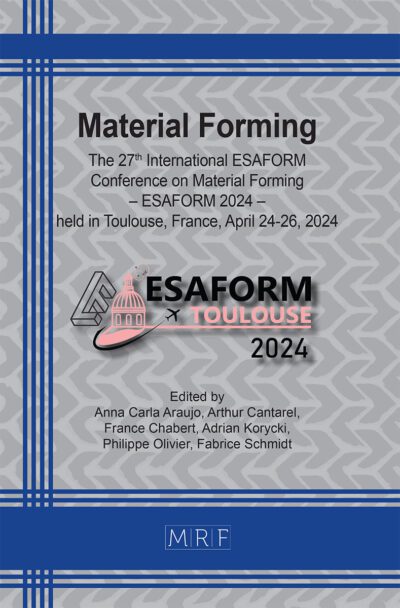Experimental, analytical, and numerical analysis of clinched-assisted electromagnetic forming of AA1100 sheet
Rakesh Kumar Mishra, Ashish Rajak
Abstract. AA1100 sheets have vast applications in the automobile, aerospace, heat exchangers, and nuclear industries. Clinching is a mechanical joining method using a simple tool set consisting of a punch, a die, and a punch holder. Electromagnetic forming (EMF) is a high-strain rate forming process that uses the Lorentz force to shape the workpiece. This manuscript compares the formability analysis of electromagnetic forming of the clinched and non-clinched workpieces of a thickness of 1 mm. Two sheets of the same thickness were clinched along the width. Analytical studies were conducted to calculate a magnetic field developed in the rectangular spiral coil. Furthermore, a numerical analysis was carried out using an LS DYNA explicit solver for clinching and EMF processes to verify the experimental results.
Keywords
Clinching, Electromagnetic Forming, Fiber Backing Plate, LS DYNA
Published online 5/7/2025, 10 pages
Copyright © 2025 by the author(s)
Published under license by Materials Research Forum LLC., Millersville PA, USA
Citation: Rakesh Kumar Mishra, Ashish Rajak, Experimental, analytical, and numerical analysis of clinched-assisted electromagnetic forming of AA1100 sheet, Materials Research Proceedings, Vol. 54, pp 1239-1248, 2025
DOI: https://doi.org/10.21741/9781644903599-135
The article was published as article 135 of the book Material Forming
![]() Content from this work may be used under the terms of the Creative Commons Attribution 3.0 license. Any further distribution of this work must maintain attribution to the author(s) and the title of the work, journal citation and DOI.
Content from this work may be used under the terms of the Creative Commons Attribution 3.0 license. Any further distribution of this work must maintain attribution to the author(s) and the title of the work, journal citation and DOI.
References
[1] J. Mucha, The effect of material properties and joining process parameters on behavior of self-pierce riveting joints made with the solid rivet, Materials & Design (1980-2015), . 52 (2013), 932–946. https://doi.org/10.1016/j.matdes.2013.06.037
[2] K. Mori, Y. Abe, T. Kato, Mechanism of superiority of fatigue strength for aluminium alloy sheets joined by mechanical clinching and self-pierce riveting, Journal of Materials Processing Technology, 212 (2012), 1900–1905. https://doi.org/10.1016/j.jmatprotec.2012.04.017
[3] J. Varis, Economics of clinched joint compared to riveted joint and example of applying calculations to a volume product, Journal of Materials Processing Technology, 172 (2006), 130–138. doi: 10.1016/j.jmatprotec.2005.09.009
[4] R. Neugebauer, F. Jesche, M. Israel, Enlargement of the application range of solid punch riveting by two-piece dies, Int J Mater Form, 3 (2010) 999–1002. https://doi.org/10.1007/s12289-010-0938-2
[5] J. P. Varis, The suitability of clinching as a joining method for high-strength structural steel, Journal of Materials Processing Technology, 132 (2003), 242–249. https://doi.org/10.1016/S0924-0136(02)00933-0
[6] R. Neugebauer, M. Todtermuschke, R. Mauermann, F. Riedel, Overview on the state of development and the application potential of dieless mechanical joining processes, Archives of Civil and Mechanical Engineering, 8 (2008), 51–60. https://doi.org/10.1016/S1644-9665(12)60121-6
[7] J. C. Zheng, X. C. He, J. N. Xu, K. Zeng, Y. F. Ding, Y. B. Hu, Finite Element Analysis of Energy Saving Jointing Method Base on Energy Materials: Clinching, AMR, 577 (2012), 9–12. https://doi.org/10.4028/www.scientific.net/AMR.577.9
[8] F. Lambiase and A. Di Ilio, Finite Element Analysis of Material Flow in Mechanical Clinching with Extensible Dies, J. of Materi Eng and Perform, 22 (2013),1629–1636. https://doi.org/10.1007/s11665-012-0451-5
[9] Y. Zhang et al., Steel‑aluminum clinched joints mechanical properties and strength prediction under different geometric parameters, Journal of Constructional Steel Research, 226 (2025),109196. https://doi.org/10.1016/j.jcsr.2024.109196
[10] C. Chen, Y. Yin, Y. Chen, X. Ran, Effect of forming parameters on the mechanical properties of clinched joint with rectangle punch, CIRP Journal of Manufacturing Science and Technology, 57 (2025), 1–13. https://doi.org/10.1016/j.cirpj.2024.12.008
[11] M. J. Worswick, R. Smerd, C. P. Salisbury, S. Winkler, D. J. Lloyd, High Strain Rate Behaviour of Aluminium Alloy Sheet, MSF, 519–521 (2006), 139–146. https://doi.org/10.4028/www.scientific.net/MSF.519-521.139
[12] D. A. Oliveira, M. Worswick, Electromagnetic forming of aluminium alloy sheet, J. Phys. IV France, 110 (2003), 293–298. https://doi.org/10.1051/jp4:20020709
[13] V. Psyk, D. Risch, B. L. Kinsey, A. E. Tekkaya, M. Kleiner, Electromagnetic forming—A review, Journal of Materials Processing Technology, 211 (2011), 787–829. https://doi.org/10.1016/j.jmatprotec.2010.12.012
[14] J. Li, L. Li, M. Wan, H. Yu, L. Liu, Innovation applications of electromagnetic forming and its fundamental problems, Procedia Manufacturing, 5 (2018), 14–30. https://doi.org/10.1016/j.promfg.2018.07.165
[15] J. K. Doley, S. D. Kore, Comparison of electromagnetic forming of friction stir-welded blanks of dissimilar material AA 5052-AA 6061 with conventional forming process, Int J Adv Manuf Technol, 93 (2017), 3789–3797. https://doi.org/10.1007/s00170-017-0793-0
[16] A. Kami, J. Shahbazi Karami, An Investigation on Three-Point Bending of Foam-Filled Double Tubes and Parameter Optimization Using Response Surface Methodology, MACS, 8 (2021). doi: 10.22075/macs.2021.20410.1259
[17] R. Mishra, A. Rajak, Investigation of backing plate effects on the formability and fracture behaviour of AA1100 sheet in electromagnetic forming: Analytical, experimental and numerical analysis, Proceedings of the Institution of Mechanical Engineers, Part L: Journal of Materials: Design and Applications, (2025),14644207241308363. https://doi.org/10.1177/14644207241308363
[18] P. Verleysen, J. Peirs, J. Van Slycken, K. Faes, L. Duchene, Effect of strain rate on the forming behaviour of sheet metals, Journal of Materials Processing Technology, 211 (2011),1457–1464. https://doi.org/10.1016/j.jmatprotec.2011.03.018
[19] G. Testa, G. Iannitti, A. Ruggiero, D. Gentile, N. Bonora, Constitutive behavior modelling of AA1100-O at large strain and high strain rates, presented at the SHOCK COMPRESSION OF CONDENSED MATTER – 2017: Proceedings of the Conference of the American Physical Society Topical Group on Shock Compression of Condensed Matter, St. Louis, MO, USA, (2018). https://doi.org/10.1063/1.5044806













